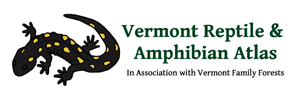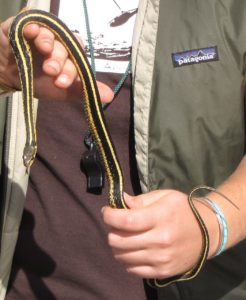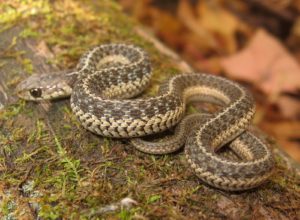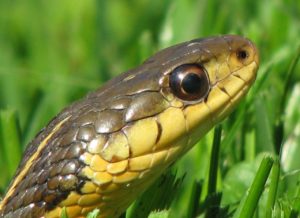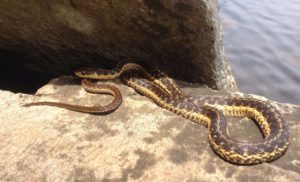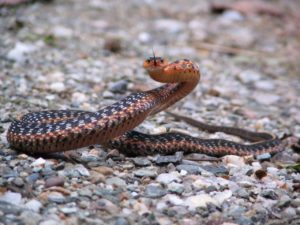Thamnophis sirtalis
Identification
The Common Gartersnake has three length-wise yellowish stripes, one on the center of the back and one on each side. The side stripes are low on the sides (scale rows 2 and 3). Portions of the stripes can be missing.
The background color can be green, black, brown, or anywhere in between. A checkerboard pattern may be visible on the sides between the stripes. The head is dark olive green with a yellow upper lip.
The tail is about 1/5 of the total length. They are usually 2-3 feet long (the longest documented in Vermont is 41 inches), with keeled scales.
Get more detailed identification and life history information by downloading the chart here.
You can learn more about this species and see some video footage by checking out this clip from our Rattlers, Peepers & Snappers DVD.
The Eastern Ribbonsnake can sometimes look similar. Key differences: 
- Eastern Ribbonsnake head markings: bright white upper lip, reddish-brown on top of head, straight black line behind eye, vertical white bar in front of eye (a very rare snake in Vermont).
- Common Gartersnake head markings: yellowish upper lip, olive green on top of head, no black line behind eye, no vertical white bar in front of the eye, yellowish “ear” spots (a very common snake in Vermont).
View or download a poster of the two snakes showing the differences: Wanted: Ribbonsnake sightings poster
Range/Habitat
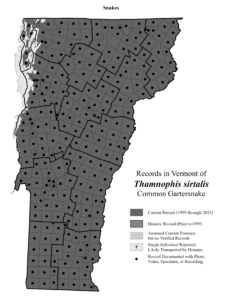
[ click image to zoom | download printable PDF ]

[ click image to zoom | download printable PDF ]
The Common Gartersnake is widespread at all elevations statewide in appropriate habitat. Since gartersnakes give live birth, they are better adapted to colder locations than those snakes that lay eggs. A combination of shallow permanent water, lots of rock or woody cover, and lots of sun is ideal for this species.
Status
This species has a state natural heritage rank of S5. It is by far the most common snake in the state. Please report sightings of this species in Vermont if you have not reported them within the last five years from a given location. Any natural history observations (feeding, migrations, road crossing areas, early or late season appearance, abnormalities, etc.) are appreciated. Photographs are always helpful, particularly if your report is the first report of this species from a town.
Additional Photos
More Info
- Thamnophis sirtalis at the Animal Diversity website
- Thamnophis sirtalis sirtalis at the Canadian Herpetological Society website
- Thamnophis sirtalis at the Snakes of Massachusetts website
Species summary written by Ariel K. McK. Burgess.
